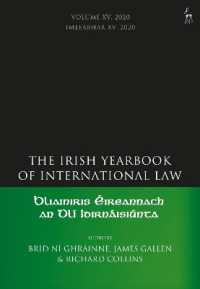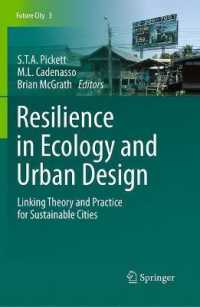- ホーム
- > 洋書
- > ドイツ書
- > Mathematics, Sciences & Technology
- > Chemistry
Full Description
A comprehensive and up-to-date look at fluidization processes
In Fluidization Processes: Design and Operation, a team of skilled engineers delivers a thorough and practical perspective on the design and operation of fluidization processes. It covers the science grounding critical fluidization concepts, including jets, bubbles, entrainment, heat transfer, particle cohesion, attrition, and general gas-solid fluidization regimes. It includes discussions of relevant calculations and modeling considerations in industrial applications.
The book offers scale-up methodologies and important design considerations for fluidization beds and cyclones. The authors also provide explanations of topics like bubbling and turbulent fluidized bed hydrodynamics, CFB riser hydrodynamics, and the components of fluidized bed units.
Readers will also find:
Thorough introductions to particle properties and fluidization and fluidization concepts
Comprehensive explorations of fluidization regimes, including examinations of Geldart particle classifications
Practical discussions of distributor designs and operations and particle elutriation and entrainment
Complete treatments of cyclone design and operations, diplegs and standpipes, and pressure loop calculations
Perfect for chemical engineers, process engineers, and environmental chemists, Fluidization Processes: Design and Operation, will also benefit catalytic chemists, materials scientists, and chemists in industries.
Contents
1. Introduction
1.1 Packed bed and CSTR overview
1.2 Fluidized bed overview
2. Industrial application
2.1 Gasification
2.2 Pyrolysis
2.3 Combustion
2.4 Cracking
2.5 Chlorination
2.6 Polyolefins
2.7 Acrylonitrile
2.8 MTBE
2.9 Polycrystalline Silicon FBR
2.10 Chemical looping
2.11 Mining and metal recovery
2.12 Dryers and Heat Treaters
3. Gas-Solid Fluidization Regimes
3.1 Particle properties
3.2 Minimum fluidization
3.3 Bubbling fluidization
3.4 Turbulent fluidization
3.5 Fast-fluidization
3.6 Transport beds
4. Jets
5. Bubbles
5.1 Bubble size
5.2 Bubble rise velocity
5.3 Bubble volume fraction
5.4 Measuring bubble bubble properties
5.5 Bubble models
6. Entrainment
6.1 TDH
6.2 Entrainment flux
7. Mass Transfer
7.1 Dispersion vs mass transfer
7.2 Models
8. Heat Transfer
8.1 Convection conduction
8.2 Radiation
8.3 Heat transfer correlations
9. Particle cohesion
9.1 Interparticle forces
9.2 Particle cluster size
9.3 Effects of entrainment
10. Particle Attrition and Erosion
10.1 Jets (Werther and Ghadiri)
10.2 Cyclones (Reppenhaggen, Werther)
10.3 Testing
11. Fluidized Bed Design
11.1 Distributor
11.2 Cyclones
11.3 Internals
11.4 Reactor modeling
11.5 Riser
11.6 Riser terminator
11.7 Stripper
11.8 Regenerator
11.9 Standpipes and diplegs
11.10 Transfer lines
12. Cyclone Design
12.1 Cyclone types
12.2 Cyclone design
12.3 Cyclone collection efficiency
12.4 Cyclone pressure drop
12.5 Diplegs
13. Pressure Loops and PL Calculations
13.1 Fluidized beds
13.2 Cyclones
13.3 CFBs
13.4 Standpipe pressure buildings
13.5 Pressure loop calculations and circulation
14. Modeling Fluidized Beds and CFBs
14.1 ROM
14.2 PBM
14.3 CFD
14.4 DEM-CFD
14.5 Hybrids
15. Scaling Up Methodologies for Fluidized Beds
15.1 Tools
15.2 Scale Up Path
15.3 Economics








